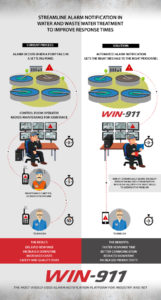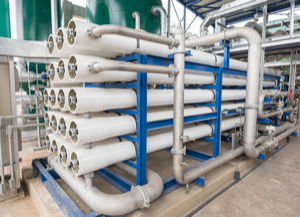 Alarm automation in municipal water systems is taking off. Aging infrastructure, increased regulation and growing populations all combine to put pressure on water treatment facilities around the world. Once an almost exclusively non-digital domain, water treatment operations management and process control software alongside SCADA systems have begun to penetrate the market as replacement and upgrade projects are undertaken.
Alarm automation in municipal water systems is taking off. Aging infrastructure, increased regulation and growing populations all combine to put pressure on water treatment facilities around the world. Once an almost exclusively non-digital domain, water treatment operations management and process control software alongside SCADA systems have begun to penetrate the market as replacement and upgrade projects are undertaken.
By leveraging the Internet of Things to connect municipal assets such as smart meters, water quality sensors, and network pressure sensors, municipalities can collect data in a cloud-based platform. Software then analyzes and reports on various aspects of utility and facility operations, sending that information to the appropriate people in the workforce, anytime it is needed, anywhere they are.
Operating Information vs. Alarm Notification
There’s a difference between reporting dashboards and alerting people to alarm conditions. The same underlying data fuels both, but current operating conditions are available to people as required through dashboards tailored to their needs. When alarm conditions are met, however, an alert system publishes that information to the right people at the right time – no matter where they are. Often in municipal systems, triple-redundant communication methods ensure a failsafe response to critical issues.
Here are the top three use-case scenarios where alarm notification in municipal water systems can be useful.
1 Water Quality
The job of water providers is to guarantee the delivery of good quality water. In the past, and still today, technicians with test kits monitor water quality at set intervals during a day. As utilities digitize operations, remote sensors that detect bacteria, turbidity and pH can monitor water quality on a continuous basis. When sensors send information about actual conditions that move too far from tolerances, the system will generate and send alerts to the appropriate personnel. 24/7 water quality monitoring improves system performance.
2 Leak Detection and Correction
Water leakage is a significant problem in aging systems. Municipalities modernizing their networks have started to include pressure sensors across their piping and sometimes even retrofitting sensors onto existing infrastructure. The sensors detect pressure spikes which may indicate blockages and lead to increased potential for leakage. If the system determines that pressures are high enough to potentially cause a leak, it sends an alarm out to maintenance crews. Conversely, if the system detects a pressure drop outside tolerances, this may indicate a pipe failure, and an alert will signal the right people. Sophisticated alarm software will send real-time condition reports, not just a generic alert, so that crews can adjust their actions based on real information as a situation unfolds.
3 Equipment Longevity
Remote monitoring sensors can oversee hundreds of key components of water treatment and distributions systems. Flow rates, valves, pipe joints, pump energy draws, filter condition, oil pressure, and temperature to name a few. An increase in flow rates, for example, might indicate sediment build up that can be flushed or scraped before a real blockage creates a more serious pipe burst problem requiring replacement. Blocked pump filters and high temperatures can indicate the need for pump maintenance before the pump suffers a failure. When critical parts of a distributed system can be monitored remotely, this saves on personnel costs and results in receiving valuable information about system health more quickly. First responders go into situations armed with more information than just “there is a problem” and can act accordingly.
Accelerating Change
Water utilities are taking their time to adopt new technologies. By the very nature of the business, water providers are risk averse. While other utilities like gas and electricity providers have been quicker to connect customers with usage information, recognizing that everyone has a mobile device, water providers are starting to move down the “smart city” path, installing smart meters at end-points and sensors in central operations and throughout their piping networks.
In North America, the aging utility workforce is also playing a role in leading more utilities to adopt operations management software. Many older utility workers are retiring. Younger professionals are more comfortable with operations management software and less comfortable with purely mechanistic systems. As the changing of the guard takes place while baby boomers retire, both the expectations and the skill sets of municipal employees will shift toward adopting digital, remote, automated systems.
For those municipalities that make the leap to alarm automation, they should be able to reduce system leakage, while improving water quality. At the same time, they will reduce capital equipment costs over the long run.
